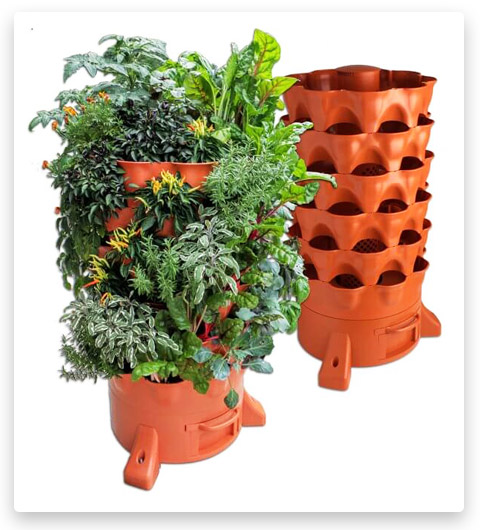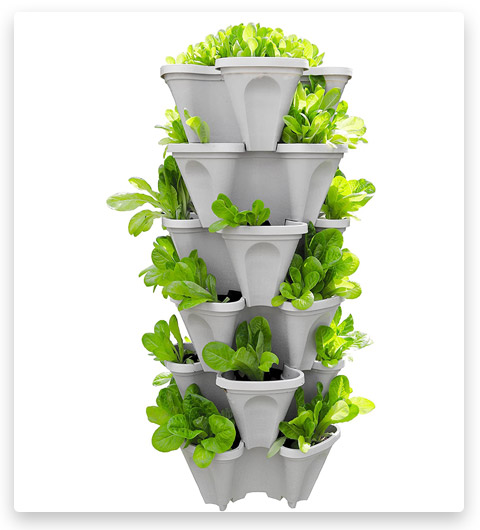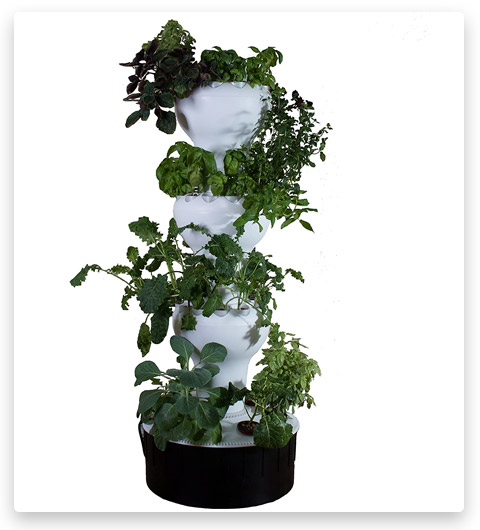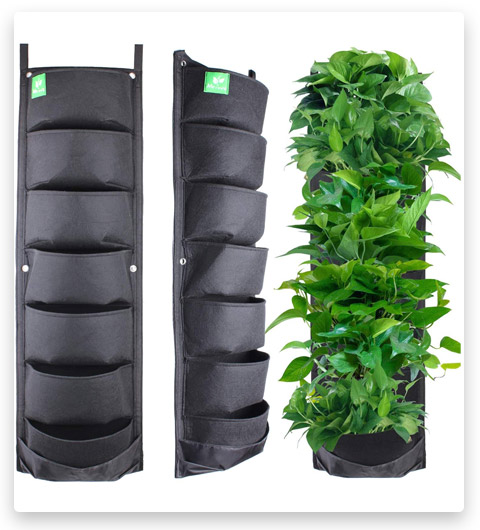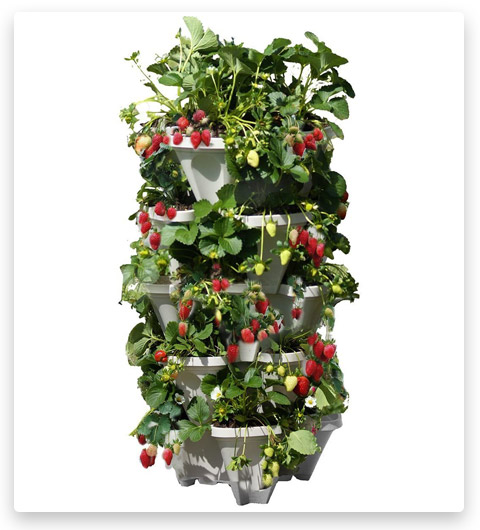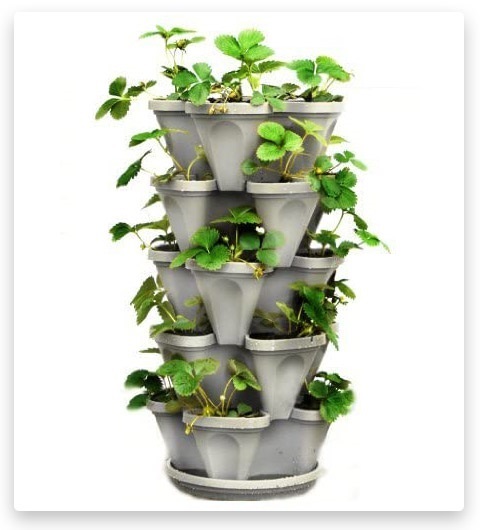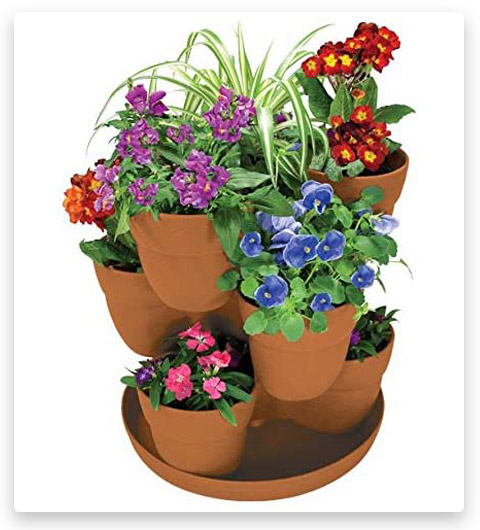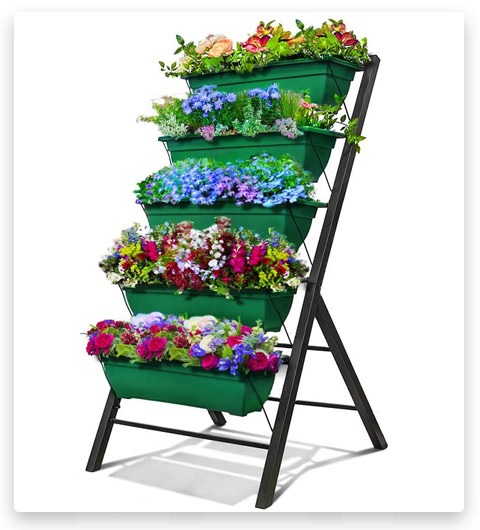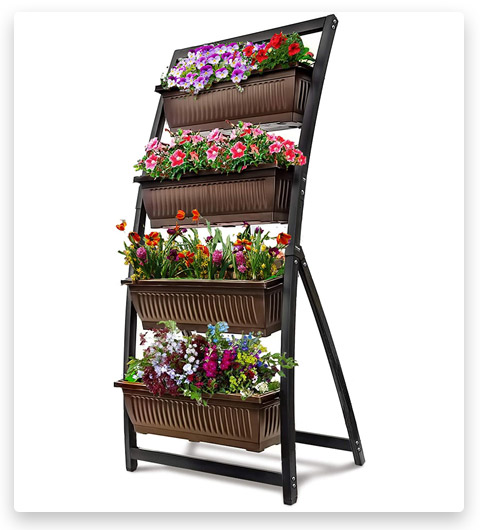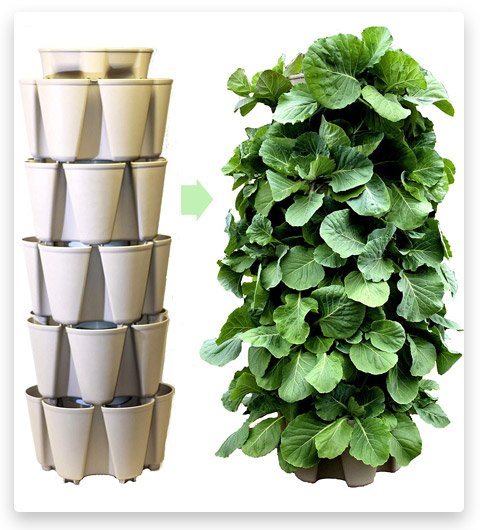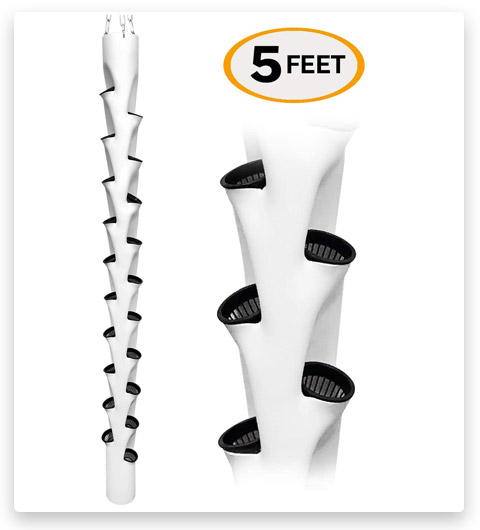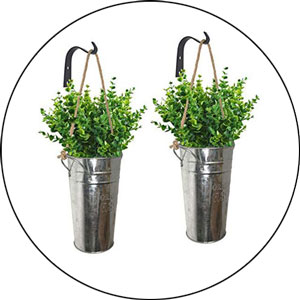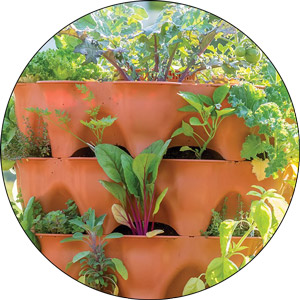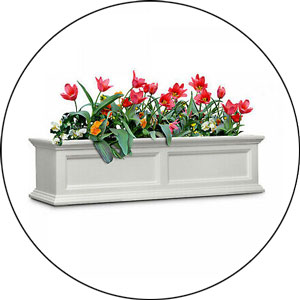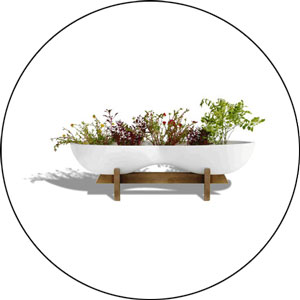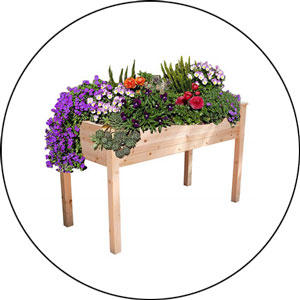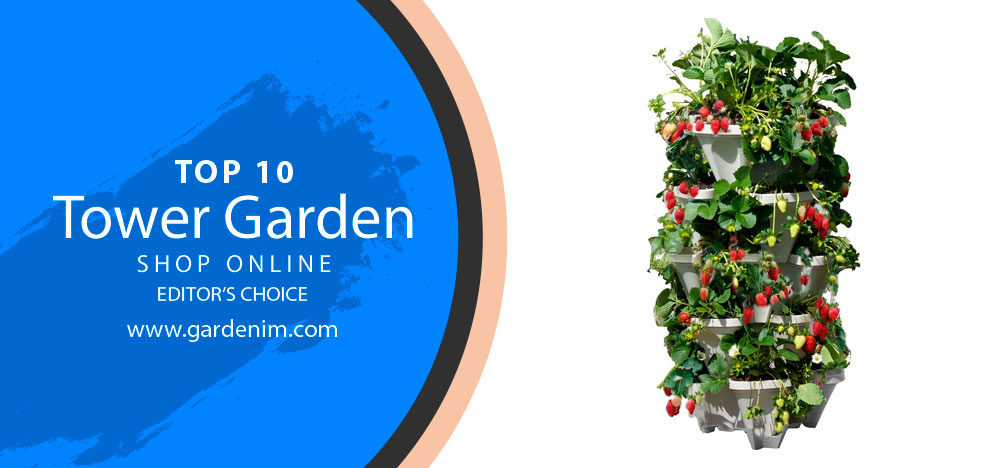
Contents
- 1 Growing Vertically: Discover the Power of Tower Gardening
- 2 Discover Garden Tower 2™: The Vertical Gardening Revolution
- 3 What’s a Tower Garden?
- 4 Digging Deep: The Roots of Tower Gardening
- 5 Top 11 Best Tower Garden Systems For Gardeners
- 5.1 #1 Revolutionize Your Gardening with Garden Tower 2™: Grow 50 Plants in 4 Sq Ft
- 5.2 #2 Runner Up – Mr. Stacky 5-Tier Tower Garden
- 5.3 #3 Best Hydroponic Garden System – Foody Vertical Garden Self Watering
- 5.4 #4 Best Compact Garden – Meiwo Vertical Garden
- 5.5 #5 Best Outdoor Garden – Mr. Stacky 5-Tier Vertical Garden
- 5.6 #6 Mr. Stacky 5-level Stackable Vertical Garden
- 5.7 #7 Emsco Group Stackable Flower Garden
- 5.8 #8 Outland Living 4-Ft 5-Tier Garden Bed
- 5.9 #9 Outland Living 6-ft Raised Garden Bed 4-Tier
- 5.10 #10 Greenstalk 5-Tier Vertical Garden
- 5.11 #11 SuiteMade PVC Vertical Grow Tower
- 6 Climbing High: The Structure and Functioning of Tower Gardens
- 7 Reach for the Sky: The Unparalleled Benefits of Tower Gardening
- 8 Your Green Tower Awaits: A DIY Guide to Building Your Own Tower Garden
- 9 Keep It Green and Serene: The Art of Maintaining Your Tower Garden
- 10 Growing Success: Real-Life Triumphs of Tower Gardening
- 11 Essential Accessories to Elevate Your Tower Garden Experience
- 12 Watch the Video on the Garden Tower Project’s official YouTube Channel
- 13 Frequently Asked Questions (FAQs) about Tower Garden
- 14 Conclusion: Harvesting the Future: The Promise of Tower Gardening
Growing Vertically: Discover the Power of Tower Gardening
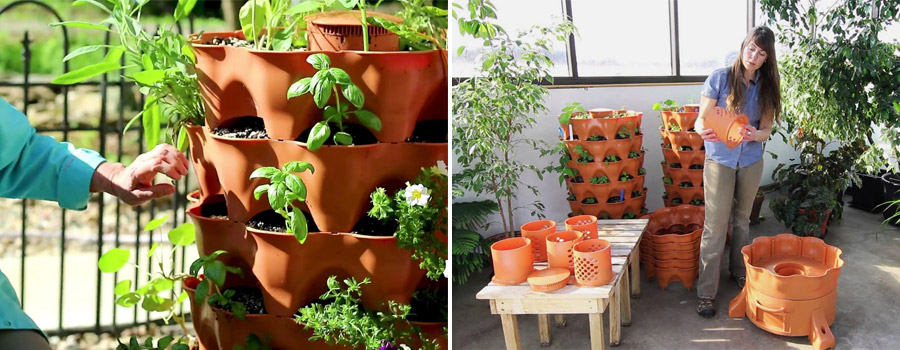
In the midst of soaring high rises and the ever-shrinking open spaces in our cities, there blossoms an innovative trend in urban gardening – the Tower Garden. The Tower Garden, as its name suggests, is a vertical, aeroponic garden that allows urbanites to grow their own fresh, healthy produce, right in the comfort of their homes or balconies. By growing vertically, the Tower Garden ensures that space, one of the most significant challenges in urban gardening, is no longer a barrier for green thumbs residing in concrete jungles.
At first glance, a Tower Garden may seem like something out of a futuristic movie set. Resembling a green column with plants sprouting out from every direction, it captures the essence of gardening in its most efficient and space-saving form. The principle behind it is simple – rather than spreading outwards, why not grow upwards? And thus, the Tower Garden creates an intriguing and attractive sight, a pillar of green, amidst the urban gray.
Now, you may be wondering, what exactly makes a Tower Garden a compelling alternative to traditional gardening? Here’s a teaser for you: Imagine growing up to 20 plants in a single square foot of space. Visualize an abundant harvest in a few short weeks, with significantly less water usage compared to conventional soil gardening. Picture a world where seasonal changes don’t impact your fresh produce, and you’re not constantly battling soil pests. Intrigued? That’s the promise of the Tower Garden – it’s a revolutionary way to approach urban gardening, with benefits that extend beyond the obvious.
Stay tuned, as we delve deeper into the world of Tower Gardening, exploring its origins, its benefits, and most importantly, how you can set up and maintain your own Tower Garden. By the end, we’re sure you’ll be eager to start your own vertical gardening journey.
Discover Garden Tower 2™: The Vertical Gardening Revolution
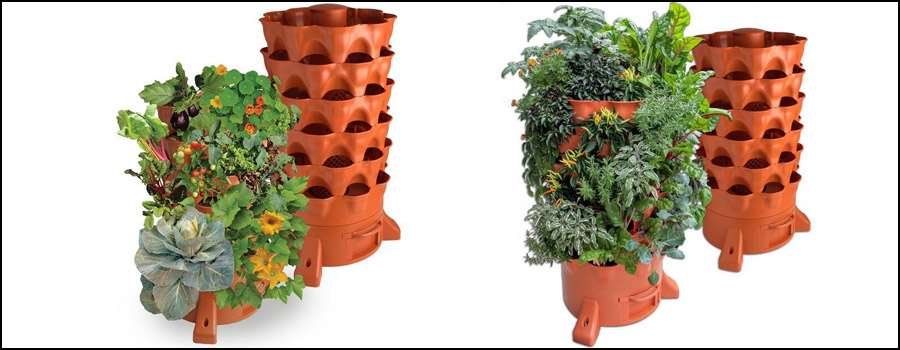
One of the biggest problems facing all gardeners today is the availability of sufficient space to grow your favorite plants. Sometimes containers with soil and seedlings take up a huge amount of space. But there is an autonomous system Tower Garden, which is created to solve this problem.
You may have heard of vertical gardens, but the Tower Garden practically doesn’t use soil, water and doesn’t need weeding. Even if you don’t know how to plant and care for them, this device will grow your products. In this article, we have collected 11 of the best Tower Gardens. Let’s look at them!
What’s a Tower Garden?
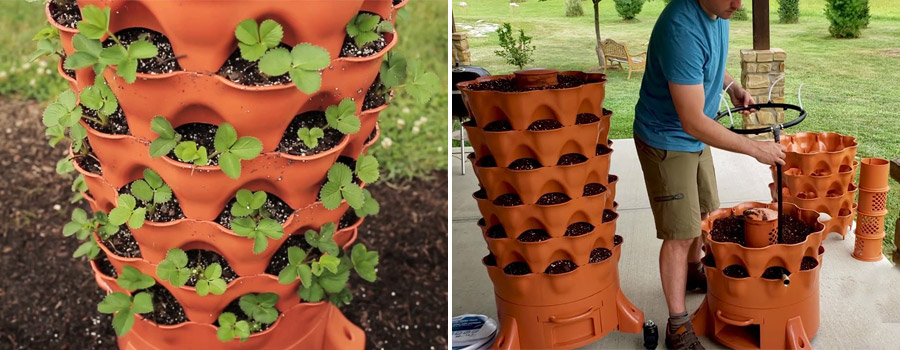
The name speaks for itself: it is a tower in which you can grow your garden. In more detail, this is a plastic container designed for growing plants. Plastic doesn’t contain dangerous chemical compounds and is resistant to ultraviolet radiation, so the plants grown here will be fully suitable for food. Depending on the design, such a garden can accommodate from 10 to 100+ plants inside. It’s much more compact, isn’t it?
Imagine if you grow each plant in a separate container and place it in the room. Using the Tower Garden is quite simple: just soak the Rockwool and place your seeds in the compartments on the tower. And Tower Garden almost doesn’t require soil.
A Tower Garden is a vertical, aeroponic growing system that allows you to grow up to 20 vegetables, herbs, fruits, and flowers in less than three square feet—indoors or out. It’s a more sustainable, space-saving, and efficient way to garden.
The Tower Garden system lets plants grow in an air or mist environment rather than in soil. It uses water and nutrients more efficiently, and because it’s vertical, you can grow a lot in a small space. This makes it an ideal choice for urban dwellers or anyone who wants to maximize their growing space.
The system also promotes faster plant growth compared to traditional soil gardening, allowing you to enjoy fresh produce year-round. Plus, because it’s soil-free, it reduces the risk of soil-borne diseases and pests. It’s an innovative, convenient, and fun way to grow your own fresh and healthy food.
Digging Deep: The Roots of Tower Gardening
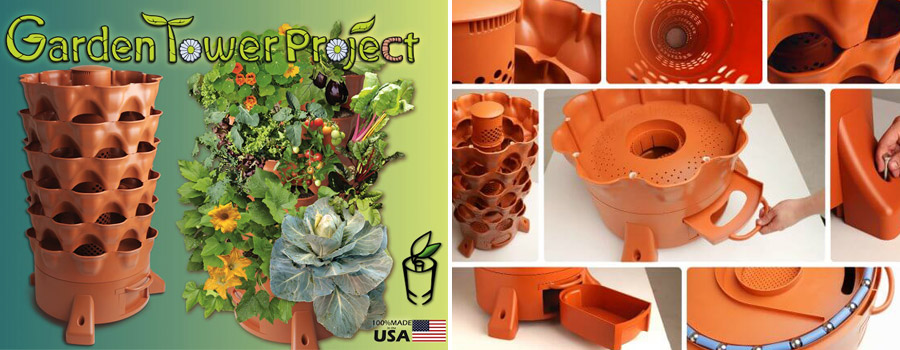
To appreciate the marvel that is the Tower Garden, it’s worth taking a brief trip down memory lane to understand the evolution of gardening itself. The roots of gardening can be traced back to the dawn of civilization when humans transitioned from a nomadic lifestyle to settled communities. These early gardens were mainly for growing food, a trend that continued through most of human history.
As civilizations advanced and populations grew, space for personal gardens began to shrink, especially with the advent of urbanization. Yet, the desire for greenery, fresh produce, and a connection to nature remained strong. Thus, innovative methods were sought to bring the joys and benefits of gardening into smaller spaces, leading to the birth of concepts such as container gardening and community gardens.
The idea of vertical gardening has its origins in the Hanging Gardens of Babylon, one of the Seven Wonders of the Ancient World. However, it was not until the modern age, with the invention of hydroponics and later aeroponics, that vertical gardening started to gain significant traction. The quest for space-saving, sustainable, and efficient ways to grow food in urban settings was the driving force behind these inventions.
Enter the Tower Garden – a perfect blend of history, innovation, and sustainability. This vertical gardening system was developed as a response to the myriad of challenges faced by urban gardeners – lack of space, water scarcity, soil degradation, and pests. By combining the principles of aeroponics and vertical growth, the Tower Garden emerged as a solution that enables anyone, anywhere, to grow their own fresh produce, regardless of space or climate constraints.
The Tower Garden has since become a symbol of the power of innovation and sustainability in the realm of urban gardening. It encapsulates the spirit of overcoming obstacles, pushing boundaries, and adapting to the circumstances – traits that have characterized gardening since its inception. And it stands as a testament to how far we’ve come in our gardening journey, while also pointing to the future of urban agriculture.
Top 11 Best Tower Garden Systems For Gardeners
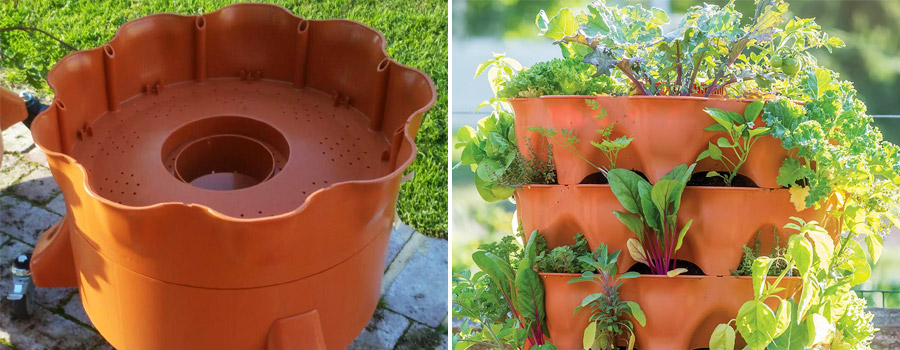
#1 Revolutionize Your Gardening with Garden Tower 2™: Grow 50 Plants in 4 Sq Ft
Experience the future of gardening with Garden Tower 2™. A vertical, composting garden planter that fits 50 plants in just 4 square feet. Easy assembly, sustainable, and perfect for urban settings. Grow a healthier, more vibrant garden today.
Discover the Power of Vertical Gardening
Awaken the nature-loving gardener in you with the Garden Tower 2™, our ground-breaking 50-Plant Composting Vertical Garden Planter. Unleash your creativity with this unique system that offers a dynamic, space-saving solution to urban gardening. It’s the epitome of sustainability, letting you grow a variety of plants – from lush vegetables to vibrant flowers – all within a compact footprint.
Revolutionary Composting System
At the heart of the Garden Tower 2™ is a game-changing composting system. Feed your kitchen scraps directly into the central column and witness how this clever design transforms them into nutrient-rich compost. It’s a closed-loop system, where your plants benefit directly from organic waste, fostering healthier, more robust growth. Experience the rewarding cycle of life, from waste to bountiful harvest.
Easy Assembly, Maximum Enjoyment
Whether you’re an experienced green thumb or a novice gardener, you’ll appreciate the ease of assembly and use of the Garden Tower 2™. It’s designed with user-friendly features, from its rotating tiers for even sunlight exposure to the easily accessible compost column. Enjoy the fruits of your labor sooner than you’d expect, with less hassle and more satisfaction.
The first thing that catches your eye when you look at this Tower Garden is that you can grow up to 50 plants with just 4 square inches! You can not only rotate this garden with one hand 360° but also adjust its height, which reduces soil sowing. This Tower Garden does not use harmful chemical fertilizers. The manufacturer made sure that everything was natural and install a system in this garden that allows you to use food waste as fertilizer. A removable drawer and a compost screen make this very easy.
If you think that you should not completely load this Tower Garden with plants, then you are mistaken. This model uses a ball bearing rotation system that does not require personal care. Also, it can withstand more than 1,000 pounds of load. The manufacturer gives you a guarantee of 5 years not without a reason. In general, the product is designed for 12 years of operation.
The main pipe in the center has more than 50 openings for full access to plant roots and improved aeration. You don’t need to be afraid that by accidentally hitting the Tower with your foot, you will drop your entire garden. Wide, heavy reinforced supports firmly attach the Tower Garden to the floor, so that even in an earthquake, your garden will survive. And of course, safety is top-notch here.
The manufacturer put this particular component in the first place in production. Plastic is resistant to UV radiation, and the design does not contain chemicals with the composition. Besides, in this version of the Tower Garden, the manufacturer reduced water consumption for use in hot climates and improved the distribution of nutrients between all plants. This is a magnificent vertical garden that you can purchase now. You can get more useful information about the brand itself and its products by reading this article – Garden Tower 2 Reviews.
#2 Runner Up – Mr. Stacky 5-Tier Tower Garden
To build this garden you do not need any tools, but it will not stand as stable as the previous unit. However, the wide surface compensates for this and gives stability. Despite its small size, this Tower Garden can accommodate up to 20 different plants. Each department blooms well no matter how intense it is watered. The design distributes moisture and fertilizer evenly. The central space is not occupied by anything, so you can use a PVC pipe or other support to fix it. Also, this will give a more free development of the roots. Garden material is very stable, does not contain chemical harmful impurities, and is resistant to ultraviolet. This model will be a great choice and will not take up much of your space.
#3 Best Hydroponic Garden System – Foody Vertical Garden Self Watering
This Garden uses a hydroponic system as its main component. When water fills the upper compartment, as soon as it reaches a certain level, it begins to descend to the lower and so to the lowest level. The coolest thing is that the roots are soaked in water for a little more than a minute, then the water goes to the next compartment, then the roots are exposed to air until the garden is full again. Thus, your plants are constantly moistened and ventilated. The only thing that can annoy is the murmur of water in the system.
Foody Garden is also quite roomy and places up to 44 plants at a time. The white color of the design gives it aesthetics. In general, from afar, it may seem that it is made of ceramic. But in fact, it is a safe plastic that is UV-resistant. Another drawback that we would note is the size of the tower. When plants reach a certain size, they begin to close each other, and then they receive less light. Slightly wider sizes – and this would be an ideal product.
#4 Best Compact Garden – Meiwo Vertical Garden
If you have no place to plant plants, then take a look at the vertical garden from the Meiwo. It is installed with a simple wall mount. Don’t worry about the fact that during watering you will wet the wall, your wallpaper will peel off. In this version of the vertical garden, the manufacturer added a waterproof bottom and back wall. So the water does not leak through the bag. The felt fabric that this garden is made of is completely safe to grow plants in it. Also, each compartment is quite spacious and holds up to 2 kg of soil. It hangs quite easily on the wall and matches the stated size. The only problem is that by overflowing the bag, the dirt will pour out from above when watering.
#5 Best Outdoor Garden – Mr. Stacky 5-Tier Vertical Garden
Pretty easy to install and use a vertical garden from Mr. Stacky. What you need if you want to save space in the garden. The garden consists of 5 levels and can accommodate up to 20 plants. Average capacity, but it saves a lot of space. Mesh pockets are good in size, foldable, and have good drainage. It plants well but needs a bottom or lining to make it easy to turn. The tower is quite solid, and even accidentally hitting it you won’t overturn it, even though there are no mounts. We would like to add that the garden design sits perfectly on the screws screwed into a PVC pipe or other support. The plastic of which the construction is made is completely safe for plants and for eating.
#6 Mr. Stacky 5-level Stackable Vertical Garden
A fairly inexpensive and high-quality vertical garden with water tanks in each department. Almost perfect for planting, strawberries, herbs, peppers, and other plants. With this garden, you save your space in the garden perfectly, and your plants will have just wild growth. Although the manufacturer does not officially declare the capacity of its product, users write that it contains a fairly large number of seeds and plants. Watering with this garden is very simple – you just water the top tiers, and water reaches the remaining levels by itself. Except for the lowest level, which you need to water additionally. The capture plate collects water that you can reuse. The plastic garden is quite durable and the parts pretty well adhere to each other. The only drawback is that the plants receive sunlight unevenly and have to turn the structure from time to time to the sun.
#7 Emsco Group Stackable Flower Garden
This garden was originally intended for growing flowers, but its compact and not high design makes it possible to grow food and save a lot of space. The seeder consists of three levels and holds from 9 to 12 plants, each capsule holds plants in pots up to 5 inches. It is very convenient that you don’t need to dig up anything if you want to replace your plants. Since the pots are at different heights and receive sunlight unevenly, the manufacturer has installed a rotating base below for a convenient turn. Each capsule and base is made from a safe polymer that is resistant to UV radiation, so nothing threatens your plants.
#8 Outland Living 4-Ft 5-Tier Garden Bed
The design of this garden consists of 5 tiers and has the appearance of a “ladder”, which is why no plant closes to another and everyone receives the same and maximum amount of sunlight. Strong metal support won’t allow your garden to fall at a gust of wind or an accidental collision. Each container of this seeder is 24 inches long and holds about 20 plants. In general, you can plant up to 100 plants here.
The assembly also does not take much time, for this, you need only 1 screwdriver and about 10 minutes. Pots can be easily removed after installation if you need to move the entire seeder. Very cool made irrigation system. As soon as the water reaches the bottom in the upper tier, with the help of the holes in the container, it begins to flow down the tier below and so on. As a result, you get all your plants watered and ventilated.
#9 Outland Living 6-ft Raised Garden Bed 4-Tier
Seeder from the same manufacturer as the previous model, but with 4 tiers and a redesigned one. This design is much easier due to the lack of one tier and a lighter metal alloy. However, the supports are still as strong. In total, this seeder can accommodate about 70-80 plants. A cascade irrigation system is installed here – when water reaches the bottom of the upper container, it begins to flow into the container one level lower, etc., which is very convenient.
Although the frame is durable, many users note that the containers are made of rather fragile plastic and they often break when they arrive. But the manufacturer always compensates for damaged parts, so don’t worry. The assembly is very quick and uncomplicated, it takes only 5-10 minutes, from tools you only need a screwdriver.
#10 Greenstalk 5-Tier Vertical Garden
Vertical seeder made of high-quality propylene, which doesn’t harm you or your plants. The irrigation system in this garden is slightly different from others. If others oversaturate the upper tier with water and then fill the lower tiers, this system saturates all levels simultaneously. Also, the model has an almost perfect height – you don’t need to raise your hand too high or bend down, especially if you have problems with your back. GreenStalk vertical garden can grow more than 20 plants, while it occupies a very small area. It really looks like it will last for many years.
#11 SuiteMade PVC Vertical Grow Tower
If all the previous vertical gardens were installed on the floor or attached to the wall, then this model is slightly different from them. It is attached using metal chains with an adjustable length. This method of fastening is not only convenient but also allows you to rotate the garden. You can choose between 16 or 20 holes. A pretty average figure, but given the low price, you can buy 2 or 3 pieces at once. Pots are easy to use and clean. This vertical garden has a very flexible irrigation system. You can use either a separate tank for each hanging garden or water all at once from one large tank.
Climbing High: The Structure and Functioning of Tower Gardens
At its most basic, a Tower Garden is a vertical, aeroponic system that allows you to grow a multitude of plants in a compact space. It essentially turns the concept of traditional horizontal gardening on its head (or rather, on its side) by promoting upward growth. But what does this all mean in practical terms? Let’s dissect the components of a Tower Garden to understand it better:
| Feature | Description |
|---|---|
| Structure | The Tower Garden is a tall, cylindrical tower made of durable, UV-resistant plastic. The core contains a reservoir that holds water and plant nutrients. Around the core, multiple slots or ports accommodate net pots with seedlings. The number of slots typically ranges from 20 to 50. |
| Aeroponic System | The Tower Garden operates on aeroponics, a form of hydroponics where plant roots are periodically misted with nutrient-rich water. A low-energy pump at the tower’s base lifts the nutrient solution to the top. The solution then trickles down, bathing all plant roots. This system promotes faster plant growth than soil, conserves water, and eliminates the need for harmful pesticides. |
| Vertical Design | The vertical design ensures all plants receive adequate sunlight, air, and nutrients, regardless of their position on the tower. This efficient use of space allows the Tower Garden to house many plants within a small footprint. |
| Plant Varieties | The Tower Garden can support a wide range of plant types, including leafy greens, herbs, fruits, and flowers. Certain root vegetables and vining plants may not be suitable, but overall, the system offers impressive versatility. |
The beauty of a Tower Garden lies in its simplicity. Despite the advanced technology that powers it, the user interface is straightforward. With minimal setup, regular filling of the reservoir, and periodic checks for plant health, you can maintain a thriving garden that offers a fresh supply of produce right at your doorstep.
To really visualize this remarkable system, images, diagrams, and infographics can offer a more concrete understanding. Picture a sleek, green tower standing tall on your balcony or in your living room, with a variety of vibrant, healthy plants jutting out from all sides. With a Tower Garden, this vision can be your reality.
Reach for the Sky: The Unparalleled Benefits of Tower Gardening
A stroll through the advantages of a Tower Garden highlights not just its benefits but also its brilliance. The tower concept of vertical gardening brings a host of advantages to the table, especially when contrasted with traditional gardening methods:
| Benefit | Explanation |
|---|---|
| Space-Efficient | The Tower Garden grows upwards, accommodating 20-50 plants within one square foot. This vertical design is ideal for urban spaces, allowing you to cultivate a variety of plants in a small apartment, balcony, or patio. |
| Water Conservation | Thanks to aeroponic technology, Tower Gardens use approximately 95% less water than soil-based gardening and 40% less than traditional hydroponics. In an era of increasing water scarcity, this conservation feature is incredibly beneficial. |
| Faster Growth and Higher Yields | The constant access to water, nutrients, air, and light leads to faster plant growth and higher yields. Crops in a Tower Garden often mature significantly faster than they would in soil, offering more frequent harvests. |
| Elimination of Soil Pests and Weeds | Without soil, Tower Gardens sidestep issues like weeds and soil-borne pests, leading to healthier plants and reducing the need for harmful pesticides. |
| Year-Round Production | Unlike traditional gardens, Tower Gardens can produce crops year-round, given the right light and temperature conditions. This feature ensures a constant supply of fresh herbs and salad greens, regardless of the season. |
| Sustainability | With their efficient use of water and space, along with their nutrient recycling capabilities, Tower Gardens represent a highly sustainable form of gardening. This aligns with the increasing global emphasis on sustainable living and urban agriculture. |
In contrast, traditional gardening requires more space, uses more water, and is often subject to seasonal variations, soil quality, pests, and diseases. Crop yield in traditional gardening can be substantial, but it usually takes more time compared to a Tower Garden. Furthermore, traditional gardening may require more labor, particularly in weddings and managing pests.
In a nutshell, Tower Gardening is an innovative, efficient, and sustainable method of urban agriculture that brilliantly solves many of the challenges faced in traditional gardening. Its advantages make it an appealing choice for urban dwellers and environmental enthusiasts alike.
Your Green Tower Awaits: A DIY Guide to Building Your Own Tower Garden
Embracing the power of vertical gardening with a Tower Garden begins with a straightforward setup process. Here’s a detailed step-by-step guide on how you can set up your very own Tower Garden:
✅Select the Right Tower Garden Kit: Tower Gardens come in a variety of models, with differences in size, number of plant slots, and features. Choose a model that best fits your available space, budget, and gardening goals. Most Tower Garden kits will include the tower structure, a base with a reservoir, a pump, a timer, net pots, rockwool or other growing medium, and a starter nutrient solution.
✅Choose the Ideal Location: The location of your Tower Garden will significantly influence your plant’s health. It should be a place that gets ample sunlight (at least 6-8 hours for fruiting plants), has access to a power source (for the pump), and is easy for you to monitor. Indoor Tower Gardens will need artificial grow lights for successful growth.
✅Assemble the Tower Garden: Follow the manufacturer’s instructions to assemble your Tower Garden. Typically, this involves setting up the base and reservoir, attaching the pump, constructing the tower, and finally attaching the top cap. Ensure all parts are securely fitted to prevent leaks or instability.
✅Prepare the Seedlings: While you can purchase ready-to-go seedlings, starting your own gives you a broader range of plant options. Use rock wool cubes or similar non-soil mediums to germinate your seeds. Once the seedlings have developed a good root system, they’re ready to be inserted into the Tower Garden.
✅Plant Your Tower Garden: Insert the seedlings into the net pots in the tower, making sure the roots reach into the inner part of the tower where they will get the nutrient mist. Remember to position larger, heavier plants at the bottom and lighter, smaller ones at the top.
✅Fill the Reservoir and Start the System: Fill the reservoir with water and add the recommended amount of nutrient solution. Switch on the pump and make sure the nutrient solution is reaching all the plants.
As for the best plants for your Tower Garden, most herbs (like basil, mint, and dill), leafy greens (like lettuce, spinach, and kale), and smaller fruiting plants (like strawberries and cherry tomatoes) are excellent choices. Avoid large fruiting plants or root vegetables as they may not be well-suited for the Tower Garden setup.
With your Tower Garden assembled and planted, your journey toward sustainable urban gardening has officially begun. Regular maintenance, including checking the water level, pH, and nutrient concentration, as well as monitoring plant health, will ensure a bountiful harvest from your vertical green tower.
Keep It Green and Serene: The Art of Maintaining Your Tower Garden
Once your Tower Garden is assembled and the plants are thriving, the real joy of gardening begins. Maintaining a Tower Garden is significantly easier than traditional soil gardening, but it does require regular care and monitoring. Here are some crucial tips to help you keep your tower lush and productive:
| Maintenance Task | Explanation |
|---|---|
| Water and Nutrient Check | Since the Tower Garden relies on a nutrient-rich water reservoir, it’s crucial to regularly maintain the water level and nutrient concentration. Refill the water weekly and replace the nutrient solution every 2-3 weeks. Keep the water pH between 5.5 and 6.5 for optimal nutrient absorption, using a pH test kit for measurement. |
| Sunlight and Temperature | Ensure your plants receive sufficient light: 6-8 hours of sunlight outdoors or use of grow lights indoors. Also, monitor the temperature, as extreme heat or cold can affect plant health. |
| Plant Monitoring and Pest Control | Regularly inspect your plants for signs of disease or distress, such as yellowing leaves, slow growth, or spots, which might indicate a nutrient imbalance or pest issue. If pests are spotted, use organic methods to control them. |
| Cleaning and Sanitizing | Regular cleaning keeps your system functioning smoothly. Algae can grow on the tower’s exterior due to sunlight exposure. To manage this, clean the tower every few weeks with a non-toxic, biodegradable cleaner. |
| Pruning and Harvesting | Regular pruning encourages bushier growth and higher yields. Always harvest your crops frequently to promote further growth and to prevent the plants from becoming too heavy, which could cause the tower to topple. |
In terms of troubleshooting common problems, if your plants look wilted or unhealthy, check the water, pH level, and nutrient concentration in the reservoir. If the pump fails or becomes noisy, inspect it for blockages or consider replacing it. If your plants aren’t growing as fast as they should, check if they’re getting enough light and adjust accordingly.
With these maintenance and troubleshooting tips, your Tower Garden should continue to thrive, providing you with fresh, homegrown produce for many seasons to come. The joy of seeing your very own ‘green tower’ flourish is well worth the effort involved in its upkeep.
Growing Success: Real-Life Triumphs of Tower Gardening
The proof of the Tower Garden’s efficacy lies not just in its innovative design and scientific basis, but also in the myriad of success stories from its users. Here are a few notable ones:
☑️The Urban Farmer: Jane, a resident of New York City, had always dreamt of having a garden. But living in an apartment left her with very little space. When she discovered the Tower Garden, it revolutionized her urban living experience. Using just her balcony, she was able to grow an assortment of herbs, leafy greens, and small fruits. Not only did it add a touch of green to her concrete jungle, but it also allowed her to enjoy fresh, homegrown produce year-round.
☑️The School Project: A local elementary school in Los Angeles used Tower Gardens as part of its science curriculum. Each class was responsible for their tower, learning about plant life cycles, photosynthesis, and sustainability in a hands-on manner. The project culminated in a ‘harvest day,’ where the children enjoyed a healthy salad made from their own Tower Garden produce. It instilled in them a love for gardening, healthy eating, and environmental awareness.
☑️The Community Garden: In a small community in Texas, space and water scarcity were significant issues. The introduction of Tower Gardens transformed an underused lot into a thriving community garden. Residents were able to grow a variety of crops, contributing to local food security, promoting social interaction, and revitalizing the community spirit.
As for scientific research, numerous studies validate the benefits of Tower Gardens. A study published in the Journal of Agricultural Studies found that plants grown in aeroponic systems like the Tower Garden had a faster growth rate and higher yield compared to those grown in soil.
Moreover, research from the University of Mississippi highlighted that Tower Gardens used 90% less water than traditional gardens, validating its water conservation claims. They also found that due to the absence of soil, crops were less prone to diseases and pests.
These individual, community, and educational success stories, backed by scientific research, offer powerful testimony to the potential of Tower Gardens. From improving diet to educating young minds, from fostering community to conserving resources, Tower Gardens have proven its worth on multiple fronts.
Essential Accessories to Elevate Your Tower Garden Experience
The art of gardening has ascended, quite literally, to new heights. Tower Gardening, a revolutionary vertical farming method, is paving the way for urban dwellers to cultivate their green thumb. Whether you are an avid gardener running out of horizontal space, or a city dweller looking to imbibe the freshness of nature in your high-rise apartment, a Tower Garden opens the doors to sustainable living.
But what if you could further enhance your tower gardening experience? We are not just talking about the necessary seedlings, water, and sunlight. Today’s discussion revolves around the various accessories for your Tower Garden that can optimize your gardening practice and yield.
The Need for Accessories in Tower Gardening
Just like how a fisherman needs a variety of gear for a successful fishing trip, gardeners need specific accessories to make their gardening journey smoother and more productive. In the world of Tower Gardening, these accessories are not merely add-ons; they are critical elements that can significantly influence the success of your vertical garden.
In Tower Gardening, the plants are stacked vertically, leaving no room for traditional gardening tools. Here, specialized accessories come into play, making it easier to maintain the garden, optimize plant growth, ensure the health of the plants, and eventually improve the yield. Moreover, with the right accessories, you can easily overcome the challenges of limited sunlight, changing seasons, and indoor gardening.
If you want to grow a good crop, then just a tower garden won’t be enough. It may also require additional accessories that’ll help to better care for them and provide them with better growth. We have prepared for you a list of the most useful accessories for your tower garden.
List and Description of Essential Accessories
As we delve into the world of Tower Garden accessories, it’s important to remember that each accessory has a specific role to play in enhancing your gardening experience. These are not just ‘nice-to-have‘ items; they can be ‘game-changers’ that can significantly improve the health, growth rate, and yield of your plants. Let’s explore them in detail:
♊Growth Lights: Adequate light is crucial for plant photosynthesis, growth, and development. However, in indoor settings or regions with insufficient natural light, maintaining the right light levels can be challenging. This is where Growth Lights come in. These are specially designed lights that emit a spectrum ideal for plant growth. They can be easily installed with your Tower Garden, ensuring your plants receive the light they need, no matter the location or season.
♊Cages and Supports: As your plants grow, they will need support, especially for heavier or vining species. Accessories like cages and supports can provide the necessary structure to your plants, helping them grow upward without toppling or becoming too heavy for the Tower Garden. They are designed to fit seamlessly into the tower structure, making it easy to support your growing plants.
♊Weather Protection Covers: If your Tower Garden is outdoors, it may be exposed to varying weather conditions that could harm your plants. Weather Protection Covers are designed to shield your garden from harsh elements like excessive rain, snow, wind, or even intense sun. They are easy to install and remove, ensuring your Tower Garden can withstand seasonal changes.
♊Automated Timers: Consistency is key in gardening. Regular watering and light exposure can dramatically improve plant growth. Automated timers help in maintaining this consistency. They can be set to switch your growth lights on and off and even control the watering cycles. This not only ensures optimal growth conditions but also makes the maintenance of your Tower Garden easier and more efficient.
♊pH kits: For plants to absorb nutrients effectively, the pH level of the nutrient solution needs to be maintained between certain values. A pH kit is an essential tool to monitor and adjust the pH levels of your water, ensuring optimal nutrient absorption. Easy to use, a pH kit can be a vital accessory in your Tower Garden setup, leading to healthier and faster-growing plants.
♊Mineral Fertilizers: After some time, the plants absorb from the soil all the minerals there. In this case, you need to stock up on mineral mixtures with which you can cultivate the soil. Such mixtures usually come with a tower garden (Garden Tower 2 for example), but they may not be enough, and soon you will need another canister.
♊Rotating Trolley: This can be a trolley on wheels or a regular plate with a bearing. Such an accessory is needed if your sunlight falls on your plants unevenly (and this happens very often). A rotating base is needed to turn your plants to the sun. If the plants receive light unevenly, one half will grow faster than the other.
Understanding these accessories and their uses can make the difference between a good and a great Tower Garden setup. Remember, the more tailored your setup is to your plant’s needs, the better it will thrive.
How to Choose the Right Accessories
When setting up your Tower Garden, it’s essential to carefully consider which accessories you need. The right accessories will depend on your specific situation, such as the types of plants you want to grow, the location of your Tower Garden, and the climatic conditions. Here are some key factors to consider when selecting accessories for your Tower Garden:
| Factor to Consider | Explanation |
|---|---|
| Type of Plants | The kind of plants you wish to grow will significantly impact the accessories you need. For instance, vining or heavy fruit-bearing plants may require cages and supports. Conversely, if you’re planning on growing leafy greens and herbs, growth lights and a pH kit might be more crucial. |
| Location | The location of your Tower Garden also determines the accessories you’ll need. Indoor gardening or regions with limited sunlight necessitate the use of growth lights. An outdoor Tower Garden exposed to severe weather would benefit from a weather protection cover. |
| Climate | The climatic conditions in your region can affect your choice of accessories. If you live in a hot, sunny area, a weather protection cover can shield your plants from excessive sunlight. In cooler climates, protective covers may be required to protect your plants from cold winds or frost. |
| Maintenance Level | Your available time and effort for Tower Garden maintenance should also be considered. If you’re often busy, automated timers can help maintain regular watering and light cycles. |
Tips for Finding Quality and Durable Products:
Quality and durability should be key considerations when purchasing your Tower Garden accessories. Here are a few tips to help you find the best products:
| Factor to Consider | Explanation |
|---|---|
| Read Reviews | Before purchasing, read reviews from other users. These reviews can provide insights into the product’s performance, reliability, and durability. |
| Trusted Brands | Prefer products from well-known and trusted brands. While they might be a bit pricier, these brands often provide better performance and have longer product lifespans. |
| Warranty and Customer Support | Assess if the product comes with a warranty and whether the company offers customer support. These features can be highly beneficial if you encounter any issues or have questions about the product. |
| Materials | The materials used in the accessory can indicate its quality and durability. Opt for products made from sturdy, weather-resistant materials to ensure longevity. |
By carefully selecting your accessories, you can ensure your Tower Garden is as productive and low-maintenance as possible.
How to Use and Maintain Accessories
In a Tower Garden, the effective use and regular maintenance of accessories can make a significant difference in your gardening success. Let’s explore some key accessories and tips for their proper use and maintenance:
| Accessory | Usage | Maintenance |
|---|---|---|
| Growth Lights | Essential for indoor gardening or in regions with limited sunlight. Hang the lights above the Tower Garden, ensuring the entire structure is adequately illuminated. Ensure appropriate distance to prevent overheating or burning the plants. | Regularly clean the lights to remove dust and debris. Replace the bulbs as needed. |
| Cages and Supports | Useful for heavy fruit-bearing plants or vining species. Attach to the Tower Garden according to the manufacturer’s instructions. As plants grow, guide them onto the supports. | Regularly monitor for signs of strain on the structure and adjust as necessary. |
| Weather Protection Covers | Safeguard the Tower Garden during harsh weather conditions. Drape the cover over the Tower Garden during extreme weather and remove it when conditions improve. | Keep the covers clean and properly stored when not in use. |
| Automated Timers | Aid in maintaining efficient watering and light cycles. Install according to the manufacturer’s instructions and program according to the plants’ needs. | Regularly check the timer to ensure it’s functioning correctly. |
| pH Kits | Key for maintaining optimal pH levels for nutrient absorption. Use to test the water in the Tower Garden regularly. Adjust the pH using pH up or down solutions as necessary. | Keep the kit clean and properly stored when not in use. Regular calibration might be needed to ensure accurate readings. |
Each accessory comes with its unique set of maintenance needs, but a few general tips include regularly checking all accessories for signs of wear and tear, cleaning them regularly, and storing them correctly when not in use. Regular maintenance will prolong the life of the accessories and keep your Tower Garden in top condition.
Watch the Video on the Garden Tower Project’s official YouTube Channel
Frequently Asked Questions (FAQs) about Tower Garden
Conclusion: Harvesting the Future: The Promise of Tower Gardening
Having studied each vertical garden on this list, we decided to identify the best model. This is 1# Garden Tower 2 Composting 50 Plant Organic Container Garden. This is the most innovative system available at the moment. Maybe its price is above average, but the quality that you get is worth it. Vertical organic patio farming made simple – The Garden Tower(R) uses natural technology to supercharge modern container gardening. The Garden Tower is the only planter system that integrates composting and nutrient recycling turning kitchen scraps into organic veggies!
🆘Benefits & Features:
- Grow 50 plants & vegetables in 4 Sq. Feet
- Compost & garden in one — nutrient-rich gardening
- Faster growth than any other garden
- Minimal upkeep & no weeding required
- Rotates for easy accessibility
- Award-winning innovation & design
Tower Garden 2 is very versatile and durable, has everything you need to ensure that your plants thrive from year to year, and gives you an excellent harvest. If you want something good for your plants, then this will be the best choice for you.
In this journey through the concept, benefits, setup, and maintenance of Tower Gardens, we’ve seen how this revolutionary system can transform the way we approach urban gardening. Embodying sustainability and efficiency, Tower Gardens offer a brilliant solution to space constraints, resource conservation, and year-round crop production.
From understanding the basic concept and structure of a Tower Garden, we delved into its numerous benefits. These include its space-saving nature, substantial water conservation, higher and faster crop yields, and the bonus of eliminating common soil-related problems. The step-by-step guide provided a clear roadmap for setting up a Tower Garden and suggested suitable plants for your vertical garden.
Maintenance and troubleshooting advice will prove useful in ensuring the longevity and productivity of your Tower Garden. The heartening success stories of Tower Garden users, along with supporting scientific research, underscored the potential and effectiveness of this innovative gardening system.
Urban gardening doesn’t have to be a challenge, and you don’t need a traditional garden to grow your own food. With a Tower Garden, you can transform any space into a lush, productive garden, bringing nature’s bounty right to your doorstep. This remarkable gardening solution not only contributes to a healthier lifestyle but also nudges us toward a more sustainable future.
Take the leap, explore the potential of Tower Gardens, and be part of the global movement towards greener, healthier, and more sustainable urban living. Happy gardening!
Join the Green Revolution: Your Call to Act
Knowledge is a seed that grows when shared. If this article has enlightened you about the wonders of Tower Gardening, why not spread the word? Share it with friends, family, or anyone you think might benefit from discovering this form of urban gardening. By doing so, you’ll be helping to cultivate a greener and more sustainable world.
Inspired to start your own Tower Garden? Excellent! Get hands-on, put the tips and steps outlined in this article into action, and experience the joy of watching your vertical garden thrive. Your tower could be a source of fresh, healthy food for your household and a symbol of sustainability in your community.
If you’re already a part of a gardening group, introduce the concept of Tower Gardening to them. If not, consider joining or initiating a local sustainable gardening initiative. Community gardens are not only places to grow food but also places to foster relationships, educate young ones, and promote a sustainable lifestyle.
Remember, every step, no matter how small it seems, contributes to a larger, collective effort toward embracing sustainability. So go ahead, sow the seeds of knowledge, nurture your Tower Garden, and watch as your efforts contribute to a greener and healthier world. Let’s garden for a sustainable future, together!
Planting More Seeds: Additional Resources for Your Gardening Journey
If you’re captivated by the potential of Tower Gardens and wish to delve deeper into the topic, here are some resources that can provide you with further information and guidance:
- Tower Garden’s Official Website (gardentowerproject.com/products/garden-tower-2-composting-container-garden?el=SS-af&sscid=61k7_a3619): A great starting point that provides detailed information on Tower Gardens, FAQs, blogs, and guides.
- “Vertical Gardening: Grow Up, Not Out, for More Vegetables and Flowers in Much Less Space” by Derek Fell. An insightful book offering tips and tricks on successful vertical gardening. It’s available on Amazon.
- “How AeroFarms’ vertical farms grow to produce“: A YouTube video from Tech Insider explaining the basics of vertical farming, which has similarities with Tower Gardens.
- “Efficiency of aeroponics and hydroponics of rock wool and perlite in strawberry production“: An interesting scientific study on the effectiveness of aeroponic systems, akin to Tower Gardens. You can read it in the Polish Journal of Agronomy.
- Vertical Garden Online: A website dedicated to vertical gardening with many useful articles, guides, and tips – verticalgardendesign.com
By exploring these resources, you’ll expand your knowledge about Tower Gardens and vertical gardening, equipping you with the insights needed to make the most of your own Tower Garden and contribute towards a more sustainable future. Happy reading and gardening!
Tags: #vertical garden system / #vertical garden system diy / #garden tower 2 / #vertical garden watering system / #garden tower 2 review / #garden tower 2 for sale / #tbest vertical garden system / #vertical garden irrigation system / #best plants to grow in a tower garden / #best tower garden fertilizer / #Composting System / #Urban Gardening / #Space-saving Gardening / #Organic Waste Recycling / #Home Composting / #Balcony Garden / #Easy Assembly Planter

